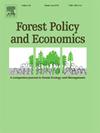基于动态DEA和机器学习的森林效率评价与预测
IF 3.8
2区 农林科学
Q1 ECONOMICS
引用次数: 0
摘要
本文提出了一种新的动态数据包络分析(DEA)方法来评估森林在提供三种关键生态系统服务方面的效率:木材生产、水产量和碳封存。碳固存被建模为结转(与地块年龄一起),而木材产量和水量被认为是产出。考虑到所考虑的输入(例如年降水量和平均温度,树木密度等)是非任意的,使用输出方向。使用加权加性归一化松弛DEA模型,计算整个时间范围内和个别时期的每个地块的效率分数。此外,还估计了每种生态系统服务的效率得分,以及相应的松弛(例如,每公顷碳固存不足)。还推导了整个样本的总效率分数。第二阶段,应用回归树(RT)和随机森林(RF)模型识别影响生态系统服务效率的样地特征。对佛罗里达州84个样地的案例研究表明,整体固碳效率超过木材生产效率,两者呈正相关。私有制和管理实践的实施提高了所有三种生态系统服务的效率,特别是在木材生产和碳封存方面。然而,干扰对效率的影响不太清楚,只有在某些海拔范围内才显得重要。在预测性能方面,RF在准确性方面优于RT,但可解释性较低。本文章由计算机程序翻译,如有差异,请以英文原文为准。
Forest efficiency assessment and prediction using dynamic DEA and machine learning
This paper proposes a novel Dynamic Data Envelopment Analysis (DEA) approach to assess the efficiency of forests in providing three key ecosystem services: timber production, water yield, and carbon sequestration. Carbon sequestration is modeled as a carryover (along with plot age), while timber production and water yield are considered as outputs. Given that the inputs considered (e.g. annual precipitation and average temperature, tree density, etc) are considered non-discretionary, an output orientation is used. Using a weighted additive normalized-slacks DEA model, efficiency scores are computed for each plot over the entire time horizon and for individual periods. Additionally, efficiency scores for each ecosystem service, along with corresponding slacks (e.g., carbon sequestration shortfall per hectare), are estimated. Aggregate efficiency scores for the full sample are also derived. In a second stage, regression trees (RT) and random forest (RF) models are applied to identify plot characteristics that affect ecosystem service efficiency. A case study of of 84 forest plots in Florida reveals that overall carbon sequestration efficiency exceeds timber production efficiency, with both positively correlated. Private ownership and the implementation of management practices enhance efficiency across all three ecosystem services, particularly for timber production and carbon sequestration. However, the impact of disturbances on efficiency is less clear and appears significant only within certain elevation ranges. In terms of predictive performance, RF outperforms RT in accuracy but offers lower explainability.
求助全文
通过发布文献求助,成功后即可免费获取论文全文。
去求助
来源期刊

Forest Policy and Economics
农林科学-林学
CiteScore
9.00
自引率
7.50%
发文量
148
审稿时长
21.9 weeks
期刊介绍:
Forest Policy and Economics is a leading scientific journal that publishes peer-reviewed policy and economics research relating to forests, forested landscapes, forest-related industries, and other forest-relevant land uses. It also welcomes contributions from other social sciences and humanities perspectives that make clear theoretical, conceptual and methodological contributions to the existing state-of-the-art literature on forests and related land use systems. These disciplines include, but are not limited to, sociology, anthropology, human geography, history, jurisprudence, planning, development studies, and psychology research on forests. Forest Policy and Economics is global in scope and publishes multiple article types of high scientific standard. Acceptance for publication is subject to a double-blind peer-review process.
 求助内容:
求助内容: 应助结果提醒方式:
应助结果提醒方式:


